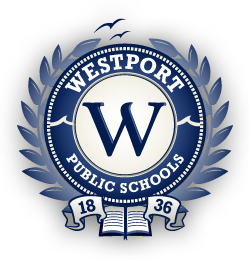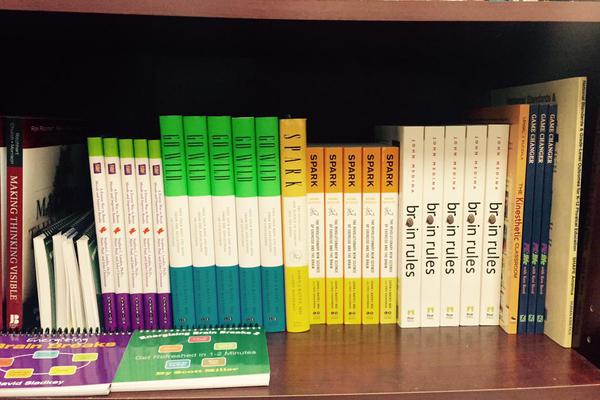NOTE from Amanda: You must follow the guest author of this post, David Gusitsch, on Twitter @WstprtWellness. In doing so, you'll follow a positive and inspiring leader who cares deeply about the physical education teachers and students in the Westport Public Schools in Westport, CT.  David's official title is K-12 Physical and Health Coordinator and I have only met him virtually via Twitter interactions, a few emails, and a Google Hangout meeting. Yet, despite never meeting in person, I am certain that he is the type of physical education leader I would want on my team.
David's official title is K-12 Physical and Health Coordinator and I have only met him virtually via Twitter interactions, a few emails, and a Google Hangout meeting. Yet, despite never meeting in person, I am certain that he is the type of physical education leader I would want on my team.
Westport Public Schools is the recipient of a Carol M. White Physical Education Program (PEP) Grant. If you are interested in a background on what the Carol M. White Physical Education Program is, please visit HERE. During a meeting with David, he said something that I never heard from someone who has received a PEP Grant before. He shared, and I paraphrase, "People think the best part of the PEP grant is about the stuff one can buy. But, it's not at all about the stuff. The best part relates to how I can support my teachers, and how I can help them support their students."
I immediately invited David to expand on Westport Public School's PEP Grant experience - from its initial application to now. The PEP grants are vital to physical education in America, and many of our leaders gather in DC each March to lobby on Capital Hill in hopes to maintain these essential funds.
Without further adieu, I present to you a guest post from David Gusitsch from Westport School District.
--------------------------------------------------------------------------------------------------------------------------------
The Carol M. White PEP (Physical Education Program) Grant has the capability of being an absolute game changer for physical education programs across the country. The word “capability” is used because just like anything else in life, nothing is guaranteed. Beginning as early as the application process, the grant takes a lot of hard work, collaboration, and willingness to be open to change.
Westport Public Schools began applying for the PEP grant after visiting the Naperville, Illinois program in the spring of 2008. The following year, we went through the process of taking a critical look at our program, gathering an incredible amount of data, collaborating with people in our community, and putting together the best application we thought possible. After this months-long process, we submitted our application by the April deadline date and waited. And waited. And waited some more, until the 2010 PEP grant winners were announced in September. Westport, CT was not on that list.
Disappointed, but not discouraged, we repeated the entire process and submitted our application by the April 2011 deadline. Five months later, when the latest round of PEP grant winners were announced, Westport, CT was once again not on the list. Strike two.
For several reasons, we were not able to apply in 2012. In 2013, we decided to apply for the third time in four years. Even if we did not win, we learned something valuable about our program, and ourselves, each time we went through the application process. September 30th, 2013, the latest PEP grant winners are announced. Before seeing the list, we received a message from someone we worked with through each of the three applications that read “Congrats, YOU WON PEP!”. That was it. No detail. Just that we won. Two days later, the government shut down indefinitely - which ended up being a little more than two weeks. We were in limbo, wondering if the grant that we had worked so for, and finally been selected for, would ever come to fruition.
Fast forward through it all, it has been an amazing experience and totally worth the hard work, worth the waiting and worth the disappointment of not being selected, twice. Below are a couple of details on how our program, each of our schools, the community at large, and most importantly, our students have benefited:
Professional development: So far, the most important aspect of the PEP grant has come in the form of professional development opportunities. Local, regional and national conferences provide the latest research, trends, and best practices in our discipline and staff members have literally connected with people from around the world. The PD does not stop at the end of each conference, but is brought back to be shared with colleagues and immediately implemented into classes. Other PD experiences include bringing some of the premier minds in our field into our district to work with our staff on curriculum improvement or educate the community on the brain/body connection and the benefits of movement in learning (#priceless).
Equipment and supplies: People often think that all of the money that is distributed for a PEP grant is spent on equipment and supplies that could have otherwise been purchased, just over a longer period of time. They are wrong. The equipment and supplies that we purchased, such as books to provoke thought and reflection, certainly enhanced our program and the learning expe
The equipment and supplies that we purchased, such as books to provoke thought and reflection, certainly enhanced our program and the learning expe
rience for students, but it is only one piece of the big picture.
Technology: Technology in our grant application was prevalent, however, we were completely committed to the notion that we only would include technology that would enhance students' learning experience. For example, heart rate monitors (HRMs) track progress and provide immediate feedback to our middle and high school students. iPads are used by students and teachers to take advantage of the endless apps that relate to fitness and wellness, and yet don't take away from their activity time. iPhad video capabilities are also used by students and teachers to record, analyze and make improvements at all levels. Projectors are used to display lesson objectives, student progress real-time (combined with HRMs), and exemplar clips from various media outlets, to name a few. SMART wall trainers provide opportunities for students to experience multi-sensory activities that stimulate the brain with various exercises using different colors, shapes, numbers, letters, sounds, and patterns. These exercises not only benefit students in the physical activity area, but carry over into the academic classrooms as well.
Education: The aforementioned brain/body connection has benefited not only health and physical education teachers, it has also been well received by teachers in other academic areas. Members of the English department have participated in our PD sessions. World Language, English, and health classrooms have cardio equipment that students may (and do) use during class to refocus and maximize their learning experience. Each of the five elementary schools embraced the notion that students need movement and have accepted kinesthetic tables in their buildings. Elementary classroom teachers have attended physically active school system workshops in our state.
Other: We are fortunate to have a PEP grant coordinator who oversees the entire operation. Some districts have a “point-person” who is expected to oversee the grant, and all that goes along with it, while still having their full-time responsibilities (e.g., teaching, admin, etc.). Our coordinator has done an excellent job of including consultants to make sure we are in compliance with all aspects of the grant as well as guide us through challenges in our program that we are looking to overcome. This is a case of “been there, done that” and not having to reinvent the wheel, so to speak.
Ever since the day that we were awarded the grant, people questioned why our district would need a PEP grant. The goal has always been to continue to build a program that showcases quality Health and Physical Education. The goal has been to educate the community about the benefits of movement in learning (i.e, not “just gym”) and educating the whole-child. The ultimate goal has been, and always will be, to provide the best experience possible for our current and future students in the Westport Public School system. The Carol M. White PEP grant has helped us realize these goals, and for that, we are grateful. Even though our grant is quantified in the span of three years, the impact that it has had on everyone will last well into the future.
David Gusitsch (@WstprtWellness) is the K-12 Coordinator for Health and Physical Education in Westport, Connecticut. Westport is a community in Fairfield County with approximately 26,000 residents. The town has five elementary schools, two middle schools, and one high school (Staples High School).






Pingback: The PE Playbook – December 2015 Edition | drowningintheshallow()